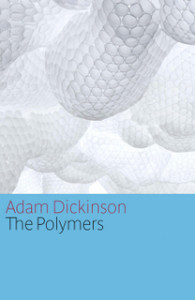by Matthew Walsh
The Polymers
Adam Dickinson
House of Anansi, 2013
Adam Dickinson’s most recent collection, The Polymers, is a fierce book of poetry. Inventive with language and form, it doesn’t shy away from a poetic experiment. Dickinson’s collection deals primarily in plastics, hence the title. What is a polymer? They range from synthetic plastics such as polystyrene to natural biopolymers, like DNA and proteins—so they are in some way connected to everything in our lives, or at least that’s what Dickinson’s poems want to show us. Split into seven section headings, titled: “Polyethylene”, “Polyester”, “Polyvinyl Chloride”, “Polypropylene”, “Polystyrene” and “Other”, and with a first page that is made of plastic, Dickinson sets his readers up for the weird journey he is determined to take them on. He includes a resin identification code describing a polymer as an “imperial dream of parades” and a “staircase to the second floor (p. 1) The first section, “Polyester”, opens with the list poem “Hail”, which begins: “Hello from inside / the albatross.” The poem is a greeting from the polymers themselves. Greetings that come from expected and surprising places, like the acrylics from a G.I. Joe, bowel-obstructed camels, and sperm. Dickinson writes list poems with a great sense of rhythm and rhyme, and lines like:
Hello from can-opened delta gators, taxidermied with twenty-five grocery sacks and a Halloween Hulk mask
(7)
He also tries out an Abecedarian and a flourish of prose poems. “Human Induced Emissions” is an example of some dynamite rhyme and wordplay, for example:
Having gumshoed a way through a peer-review, it’s deductive air ducts have resolved into the beckoned law of thermodynamics, so ice cubes don’t panic, so cold drinks don’t boil in patio feedback
(90)
The Polymers does deliver in a lot of ways. For the most part the language is evocative—who is going to stop reading after an opening line like “I hate my genitals”? (39) There are points in the collection, however, where Dickinson’s concept seems to get away from him. Poems like “Ho Hos, Ding Dongs” aren’t as thematically successful as “Human Induced Emissions”, and while the poem appears to be about human consumption and anxieties over food, any relationship to polymers is tacked on at the end of the poem. In other cases, the language somehow loses its edge in the repetition of different polymers. In some places Dickinson relies a little too much on name-dropping a few scientific words, so as the collection proceeds some redundancies are noticeable. What might have been better is if Dickinson had been a bit more economical with the length of this collection: cutting some of the poems might have benefited his intended vision. None of the poems completely fail—there is something to like about each—and Dickinson’s voice and form are playful. His poetry possesses a brilliant sparkle. Certain poems, however, like “Church and State” need not have been included. Leaving them out would only enhance Dickinson’s fantastic concept and ideas.
Matthew Walsh is currently studying Creative Writing in UBC’s MFA program. His work has been or will be featured in Arc, The Found Poetry Review, Carousel, Descant, Existere, Matrix, Carte Blanche, The Steel Chisel and as part of the Halifax Commons Poetry Anthology. His long poem “Cloud Grape” won the York University President’s Prize for poetry. He is also the recipient of the 2014 John Newlove Award for Poetry. He is currently a member of PRISM international’s editorial board.
